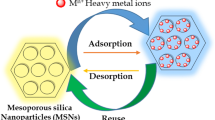Abstract
The effect of various environmentally friendly chemical additives on the dissolution of colloidal silica is systematically studied. These silica scale dissolvers are principally polycarboxylates with one to five –COOH groups, mixed polycarboxylates/phosphonates and aminoacids. Based on these results, an effort is made to link their dissolution performance to structural features in this structure/function study. Presence of additional groups (eg. –PO3H2, –NH2, or –OH) in the dissolver molecule augments the dissolution process.

Similar content being viewed by others
References
Agnihotri R, Mahuli SK, Chauk SS, Fan L-S (1999) Influence of surface modifiers on the structure of precipitated calcium carbonate. Ind Eng Chem Res 38:2283–2291
Cowan JC, Weintritt DJ (1976) Water-formed scale deposits. Gulf Publishing Co., Houston, TX
Demadis KD (2003) Water treatment's gordian knot. Chem Process 66(5):29–32
Demadis KD, Neofotistou E (2004a) Use of antiscalants for mitigation of silica fouling and deposition: fundamentals and applications in desalination systems. Desalination 167:257–272
Demadis KD, Neofotistou E (2004b) Inhibition and growth control of colloidal silica: designed chemical approaches. Mater Perform 43(4):38–42
Demadis KD (2005a) A structure/function study of polyaminoamide dendrimers as silica scale growth inhibitors. J Chem Technol Biotechnol 80:630–640
Demadis KD, Neofotistou E, Mavredaki E, Tsiknakis M, Sarigiannidou E-M, Katarachia SD (2005b) Inorganic foulants in membrane systems: chemical control strategies and the contribution of “Green Chemistry”. Desalination 179:281–295
Frenier W (2000) Technology for Chemical Cleaning of Industrial Equipment. NACE, Houston
Jendoubi F, Mgaidi A, El Maaoui M (1997) Kinetics of the dissolution of silica in aqueus sodium hydroxide solutions at high pressure and pemperature. Can J Chem Eng 75:721–727
Patwardhan SV, Clarson SJ (2002) Silicification and biosilicification Part 3. The role of synthetic polymers and polypeptides at neutral pH. Silicon Chemistry 1:207–214
Patwardhan SV, Clarson SJ (2003) Silicification and biosilicification: part 5 an investigation of the silica structures formed at weakly acidic pH and neutral pH as facilitated by cationically charged macromolecules. Mater Sci Eng C 23:495–499
Wang K-S, Resch R, Dunn K, Shuler P, Tang Y, Koel BE, Yen TF (2000) Scanning force microscopy study of etch pits formed during dissolution of a barite (001) surface in cdta and edta solutions. Langmuir 16:649–655
Zaheer Akhtar S (2000) Parallel condensing systems getting fresh look. Power Eng 104(10):63–68
Acknowledgment
To the Department of Chemistry, University of Crete for financial support.
Author information
Authors and Affiliations
Corresponding author
Rights and permissions
About this article
Cite this article
Demadis, K.D., Mavredaki, E. Green additives to enhance silica dissolution during water treatment. Environ Chem Lett 3, 127–131 (2005). https://doi.org/10.1007/s10311-005-0015-0
Received:
Accepted:
Published:
Issue Date:
DOI: https://doi.org/10.1007/s10311-005-0015-0




